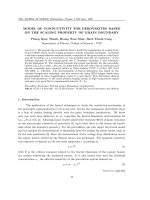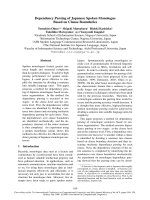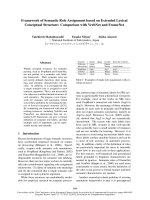Detoxification of herbicide/dioxin contaminated soil based on microbial diversity and their gene expression
Bạn đang xem bản rút gọn của tài liệu. Xem và tải ngay bản đầy đủ của tài liệu tại đây (2.37 MB, 43 trang )
2ND Meeting of
The Agent Orange Working Group
Detoxification of herbicide/dioxin
contaminated soil based on microbial
diversity and their gene expression
Assc. Prof. Dr. Dang Thi Cam Ha
Institute of Biotechnology (IBT)
Vietnam Academy of Science and Technology
(VAST)
Hanoi July 2, 2010
DANANG “HOT SPOT’
Composition of
contaminants in former
military soil
• Herbicide: 2,4,5-T: 2,4-D/ 50 : 50 (20 100
– 5 000 000 µg/kg);
• 2,3,7,8-TCDD: >99%, several thousands
to hundred thousands pgTEQ/g ;
• Other contaminants: TCP, DCP, PAHs
etc.;
• Heavy compounds of diesel oil.
Các nguồn vào/ra
Đất như một “hộp đen”
các chất diệt cỏ
khác v.v.
Sinh khốibiomass
-Đa dạng VSV đất ở mức độ nào?
- Microbial diversity?
- Bằng cách nào đánh giá được đa dạng
VSV đất? Dection of this diversity by
what kind of methods?
Các chỉ thị sinh
học bioindicators
Vi sinh vật
không nuôi cấy
được-uncultural
microbes
Các vi sinh vật nuôi
cấy được –cultural
microbes
DNA/RNA
Đa dạng VSV: đa dạng về loài
VSV và khả năng trao đổi chất
của VSV
Các nguồn
ra
0,01-10% tổng số VSV
-Total microbes
Microbial diversity: species
and their metobolisms .
Biodegradation pathways
for detoxification of herbicide/dioxin
contaminated sites
• Oxidation
• Declorination
oxy hóa cắt vòng thơm
Loại clo
• Catalyzation (extracellular enzymes: Laccase + O2,
MnP and LiP + H2O2)
Xúc tác (enzyme ngoại bào: Laccase+O2, MnP và LiP + H2O2)
• Reductive declorination
Loại khử clo không cần O 2
Bioremediation
Stimulation
Kích thích sinh học
Augmentation
Tăng cường sinh học
Phytoremediation
Xử lý bằng thực vật
All resolutions based on microbial activities: oxydation, dehalogenation and
catalysis reaction.
Tất cả các giải pháp đều dựa trên hoạt động của
VSV tham gia và oxy hóa cắt vòng, loại khử clo và
phản ứng xúc tác bởi enzyme
There are six biotechnologies which may be engineered
for detoxification of soil contaminated with herbicides
and dioxin and mixtures of other toxicants
• Aerobic bioreactor followed by secure landfill for sensitive
land uses requiring very low cleanup criteria;
• Anaerobic bioreactor for chlorinated pesticides;
• Anaerobic bioreactor followed by aerobic bioreactor for
fast mineralization of certain contaminant mixtures
(anaerobic/aerobic cycling);
• Aerobic bioreactor, either biostimulated or bioaugmented
to achieve cleanup levels rapidly;
• Phytoremediation, either by passive land treatment or
monitored natural attenuation;
• Combination of all technologies, depending on site
characterization and the contaminated properties.
In Vietnam: Active landfill for huge complex
contaminated site was developed
Microbial diversity of contaminated
site and biotreatments
(Culturable and unculturable)
Herbicide/dioxin, DDT,HCH,TNT
degrading microbes
45 bacterial strains
• 12 Actinomycete strains
• 20 Filamentous fungal strains
• 20 Anaerobic communities
•
Herbicide/dioxin anaerobic
degrading community (SEM)
After 120 day inoculation, 17% toxicity was
reduced by strain Pseumonas
sp.SETDN1
Functional gene present and expression
In soil and in purified cultures
Dioxygenase gene in dioxin and dibenzofuran
degrading bacteria isolated from herbicide/dioxin
contaminated site
HDN3
DMA
Ao3
Cây phát sinh chủng loại giữa một số
trình tự đại diện mã hóa enzym αdioxygenase và trình tự nhân lên từ
chủng Ao3, DMA và HDN3 sử dụng cặp
mồi DIOXY-F và DIOXY-R
Numbers gene tfdA of copy
in
herbicide/dioxin
contaminated
(Method:
MPN-PCR)
HDN1
HDN2
HDN3
HDN4
HDN5
HDN6
3,67 x 1,31 x 1,11 x 1,06 x 5,78 x 5,99
105
105
105
105
105
106
HDN7
HDN8
HDN9
x 2,85 x 5,27 x 5,99 x
105
105
106
Copy number catechol dioxygenase in
aerobic biotreating cells
Cell
C23O/g
M7.0
2,5 x106
M7.3
2,7 x 106
M8.0
3,7 x 105
M8.3
6,7 x 106
M9.0
2,1 x 105
M9.3
2,2 x 106
M10.0
4,6 x 105
M10.3
2,4 x 106
M11.0
2,6 x 106
M11.3
1,3 x 106
Herbicide/dioxin, DDT,HCH,TNT
degrading microbes
45 bacterial strains
• 12 Actinomycete strains
• 20 Filamentous fungal strains
• 20 Anaerobic communities
•
Detoxification of herbicide/dioxin at
different scale
1.
At the lab. Condition
2.
At field trail (0.5- 100 m3), Danang hot spot
3.
Bioreactors at lab. condition (50kg soil)
4.
Active landfill at Bien Hoa, 3384 m3
5.
VAST and EPA pilot scale (11 cells with 2 m3 soil)
Biotreatment at pilot scale in
lab. condition
Treatment
s
2,3,7,8
TCDD
concentrati
on (ppb)
0,1DN1
71.68
degradatio
n
percentage
in
comparison
to 0,1DN1
0
0,1DN2
20.76
71.04
0,1DN3
43,32
39,36
0,1DN4
31.69
55.79
0,1DN5
48.14
32.84
1A
1B
Untreated soil sample (1A) and
treatted sample (1B)
• These results indicate that different groups of microbes play
different roles in the detoxification of contaminated soil in an
examined former military base.
• After 8, 18 and 24 months in all treatments 50-70 % of toxicity
were reduced.
Soil composition change before and after treatment
1.5DN5C (Before treatment)
1.5DN5T (After two year treatment)
Fold
I
2,4,5-T Methyl ester; 2,4-D methyl ester; Acetic
acid, (2,4-dichlorophenoxy)
2,4,5-T Methyl ester
51.0
IIA
Phenol, 2,4-dichloro-; Phenol, 2,4,5-trichloro-
Phenol, 2,4-dichloro-; Phenol, 2,4,5-trichloro-
1.6
IIB
Phenol, 4,5-dichloro-2-methoxy-; Phenol, 2,4,6trichloro-; Phenol, trichloro-; Phenol, 2,6bis(1-methylpropyl); Phenol, 2,3,4,6tetrachloro-; Phenol, 2,3,5,6-tetrachloro-;
Phenol, 2,3,5-trichloro-; Phenol, 2,3,6trichloro-
Phenol, 2,4,6-trichloro-; Phenol, trichloro-;
Phenol, 2,6-bis (1,1-dimethylethyl); Phenol,
dichloro-; Phenol, 2,6-dichloro-
5.4
III
Benzene, 1,2,4-trichloro-3-methoxy; 1,2Dimethoxy-4,5-dichloro-benzene; Benzene,
dichlorodimethoxy- ; Naphthalene, 1,3,7trichloro-; Benzene, 1,2,4-trichloro-5ethoxy-
Benzene, dichlorodimethoxy-;
Benzene, 1,2,3-trichloro-4-methoxy
20.3
IVA
1-Nonadecene; 9-Tricosene, (Z)-; Nonadecane,
2-methyl-; Heptadecane; Tetradecane;
Nonadecane; Eicosane; Pentadecane;
Octadecane; Hexadecane
1-Octadecene; 1-Nonadecene;
Heptadecane;Tetradecane;
Nonadecane; Eicosane; Octadecane; Docosane
1.1
IVB
9-Octadecenamide, (Z)-; 9-Octadecenoic acid,
(E)-; Dodecanoic acid; Dodecanoic acid, 1methylethyl ester;
Octadecanoic acid; n-Hexadecanoic acid;
Tetradecanoic acid
9-Octadecenoic acid, (E)-; Dodecanoic acid;
Dodecanoic acid, 1-methylethyl ester;
Octadecanoic acid; n-Hexadecanoic acid;
Tetradecanoic acid; Nonanoic acid;
Hexadecanoic acid, methyl ester; Z-7Hexadecenoic acid
2.9
•
•
Result of GC/MS analysis indicates that 51,7% of toxicity of several hundreds µg TEQ/g was
removed after two year.
Composition change in soil sample before treatment in comparison to sample after two year
treatment. Not only 2,3,7,8 -TCDD congener was reduced, but also other herbicide contents
were decreased too. Comparing chemicals that analyzed in 1.5DN5 sample before treatment
and two year treated sample, the change of biodegrading products was detected in treated
sample. Some diesel oil compositions were also degraded. This finding shows that
bioremediation treatment can be applied for soil with high concentration of 2,3,7,8 -TCDD,
2,4,5-T and 2,4-D. Obtained data from GC/MS scanning analysis of the main existing chemicals
in soil before and after two year treatment, also shows that bioremediation treatment by ‘Active
landfill” technology providing promising tool for detoxification of heavily contaminated soils
by dioxin and other toxic compounds.
Initial toxicity:
268.000 pgTEQ/g
•
• After two year
treatment: 129.200
pgTEQ/g (51,7 %
removed)
Change in composition of 10DNT and
100DNT treatments after 24 and 29 months
Grou
p
Compouds
Samples of two year treatment from
100DNT biotreatment
Detected compounds
Pick
I
Agent
orange
Undetected
0
IIA
2,4-D-PCP
vµ
2,4,5PCP
Phenol,
2,4dichloro-;
Phenol,
2,4,5-trichloro-
573382
IIB
Other PCP
Phenol, trichloro-
172806
III
Derivatives
of Benzen
1,2Benzenedicarboxylic
acid, diis
873193
IVA
Hydrocacbo
n
oxacycloheptandeca
n-2-one;
7Hexadecene, (Z)-
262889
IVB
Cacboxylic
acid
Chlorobutanol;
9Octadecenamide,
(Z)-; n-Hexadecanoic
acid; 1-Octadecene;
Tetradecanoic acid;
Erucylamide
3526843
• 10DNT , 29 residual: 3249 pgTEQ/g, 50-70% total toxicity
removed (limit:1000 ppt)
• 100 DNT: toxicity 4499 pgTEQ/g, 50-70% total toxicity
removed
Conclusion (Danang trals)
•
•
•
•
•
Application of in situ bioremediation treatment not only dioxin was
reduced but other polluted components in soils, 2,4-D; 2,4,5-T,
TCP,DCP, PAHs also transformed or degraded. This biotechnology can
be applied for detoxification of heavy herbicide/dioxin contamination in
“Hot spots”.
Results of biodiversity indicates that different microbial groups and
species play certain role and it changes during bioremediation
treatments;
Indigenous microorganisms of long time exposure by dioxins and other
contaminants play leading role in detoxification of 2,3,7,8-TCDD, 2,4,5T; 2,4-D and other chemicals in contaminated soils;
Obtained results driving us to develop further research for enhancing
bioremediation in detoxification process of dioxins and other pollutants
in former military bases in Vietnam.
This year bioremediation in “active landfill” technology which created
by us is applying for in situ detoxification of heavy herbicide/dioxin
contaminated site at former military base of Bien Hoa, Dong Nai
province (firstly for one big cell 3384 m3).
DEVELOPMENT OF BIOTECHNOLOGY
Used aerobic and falcultative bioreactors









